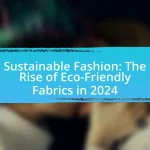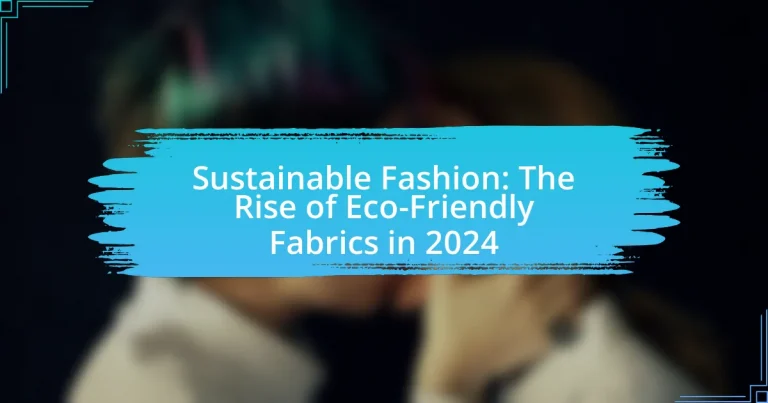Sustainable fashion, defined as clothing and accessories produced with minimal environmental impact and social responsibility, is increasingly vital in 2024 due to the fashion industry’s significant contribution to global carbon emissions. The article explores the differences between sustainable and traditional fashion, highlighting key principles such as ethical production, resource conservation, and waste reduction. It emphasizes the importance of consumer awareness in driving demand for eco-friendly fabrics, which include organic cotton, Tencel, and recycled polyester. Additionally, the article discusses emerging trends, innovations in fabric production, and the challenges faced by the sustainable fashion industry, ultimately underscoring the growing significance of eco-friendly practices in shaping the future of fashion.
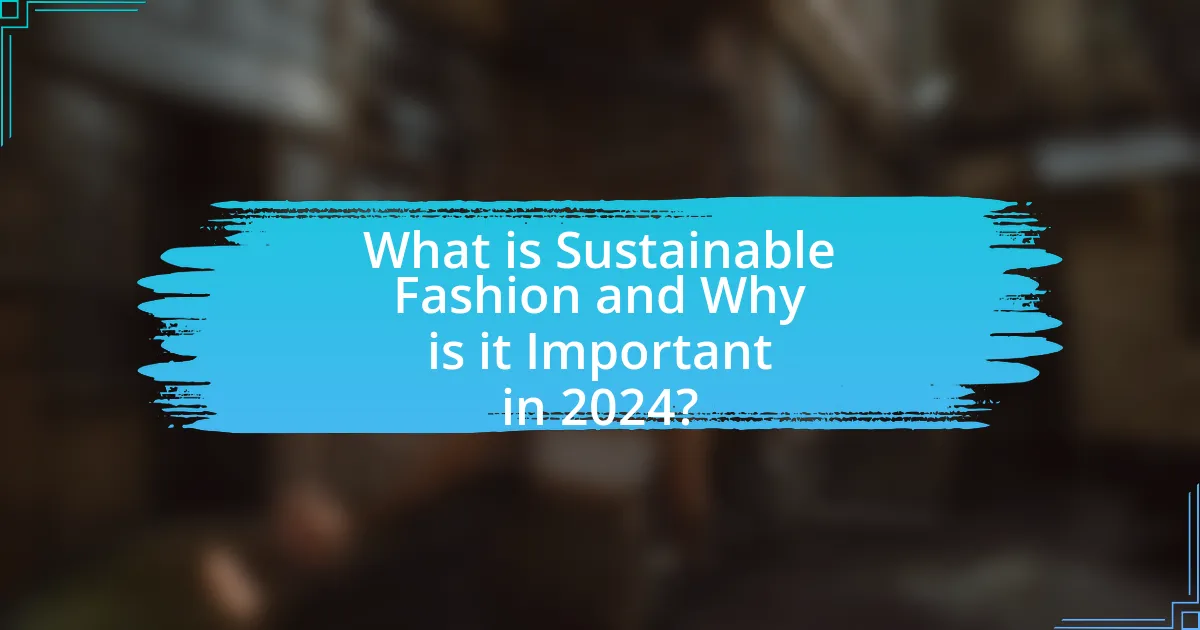
What is Sustainable Fashion and Why is it Important in 2024?
Sustainable fashion refers to clothing and accessories that are produced, consumed, and disposed of in ways that minimize environmental impact and promote social responsibility. In 2024, it is important because the fashion industry is one of the largest polluters globally, contributing to significant waste and carbon emissions; for instance, the Ellen MacArthur Foundation reports that the fashion sector is responsible for 10% of global carbon emissions. As consumers increasingly demand eco-friendly practices, brands are adopting sustainable materials and ethical labor practices to meet this expectation, thereby fostering a more responsible industry.
How does Sustainable Fashion differ from traditional fashion?
Sustainable fashion differs from traditional fashion primarily in its focus on environmental and social responsibility. Traditional fashion often prioritizes rapid production and consumption, leading to significant waste and resource depletion, whereas sustainable fashion emphasizes eco-friendly materials, ethical labor practices, and reduced environmental impact. For instance, sustainable fashion brands frequently utilize organic cotton, recycled materials, and low-impact dyes, which contribute to lower carbon footprints and less water usage compared to conventional textile production methods. This shift is supported by research indicating that the fashion industry is responsible for approximately 10% of global carbon emissions, highlighting the urgent need for sustainable practices to mitigate climate change.
What are the key principles of Sustainable Fashion?
The key principles of Sustainable Fashion include ethical production, resource conservation, and waste reduction. Ethical production emphasizes fair labor practices and transparency in the supply chain, ensuring that workers are treated fairly and compensated adequately. Resource conservation focuses on using sustainable materials, such as organic cotton or recycled fibers, which minimize environmental impact. Waste reduction involves strategies like upcycling, recycling, and designing for longevity, which help decrease the amount of textile waste generated. These principles collectively aim to create a fashion industry that is environmentally responsible and socially equitable.
Why is consumer awareness crucial for Sustainable Fashion?
Consumer awareness is crucial for sustainable fashion because it drives demand for eco-friendly products and practices. When consumers are informed about the environmental and social impacts of their clothing choices, they are more likely to support brands that prioritize sustainability. Research indicates that 66% of global consumers are willing to pay more for sustainable brands, highlighting the significant influence of consumer preferences on market trends. This awareness not only encourages brands to adopt sustainable practices but also fosters a culture of accountability within the fashion industry, ultimately leading to reduced waste and a lower carbon footprint.
What role do eco-friendly fabrics play in Sustainable Fashion?
Eco-friendly fabrics are essential in sustainable fashion as they significantly reduce environmental impact and promote ethical production practices. These materials, such as organic cotton, hemp, and recycled polyester, minimize water usage, chemical pollution, and waste generation during manufacturing. For instance, organic cotton uses 91% less water than conventional cotton and avoids harmful pesticides, contributing to healthier ecosystems. Additionally, eco-friendly fabrics often support fair labor practices, ensuring that workers receive fair wages and safe working conditions. This dual focus on environmental sustainability and social responsibility makes eco-friendly fabrics a cornerstone of the sustainable fashion movement.
What are the most popular eco-friendly fabrics in 2024?
The most popular eco-friendly fabrics in 2024 include organic cotton, Tencel (lyocell), hemp, and recycled polyester. Organic cotton is favored for its reduced pesticide use and sustainable farming practices, while Tencel is known for its biodegradable properties and low environmental impact during production. Hemp is celebrated for its durability and minimal water requirements, making it a sustainable choice. Recycled polyester, made from post-consumer plastic waste, helps reduce landfill contributions and promotes circular fashion. These fabrics are increasingly adopted in the fashion industry due to their environmental benefits and consumer demand for sustainable options.
How do eco-friendly fabrics impact the environment compared to conventional fabrics?
Eco-friendly fabrics significantly reduce environmental impact compared to conventional fabrics. Conventional fabrics, such as polyester and cotton, often require extensive water usage, harmful pesticides, and fossil fuels for production, contributing to pollution and resource depletion. In contrast, eco-friendly fabrics, like organic cotton, hemp, and Tencel, utilize sustainable farming practices, reduce chemical use, and often require less water. For example, organic cotton uses 91% less water than conventional cotton, according to the World Wildlife Fund. Additionally, eco-friendly fabrics are often biodegradable, reducing landfill waste, while conventional synthetic fabrics can take hundreds of years to decompose. Thus, eco-friendly fabrics present a more sustainable alternative that mitigates negative environmental effects associated with traditional fabric production.
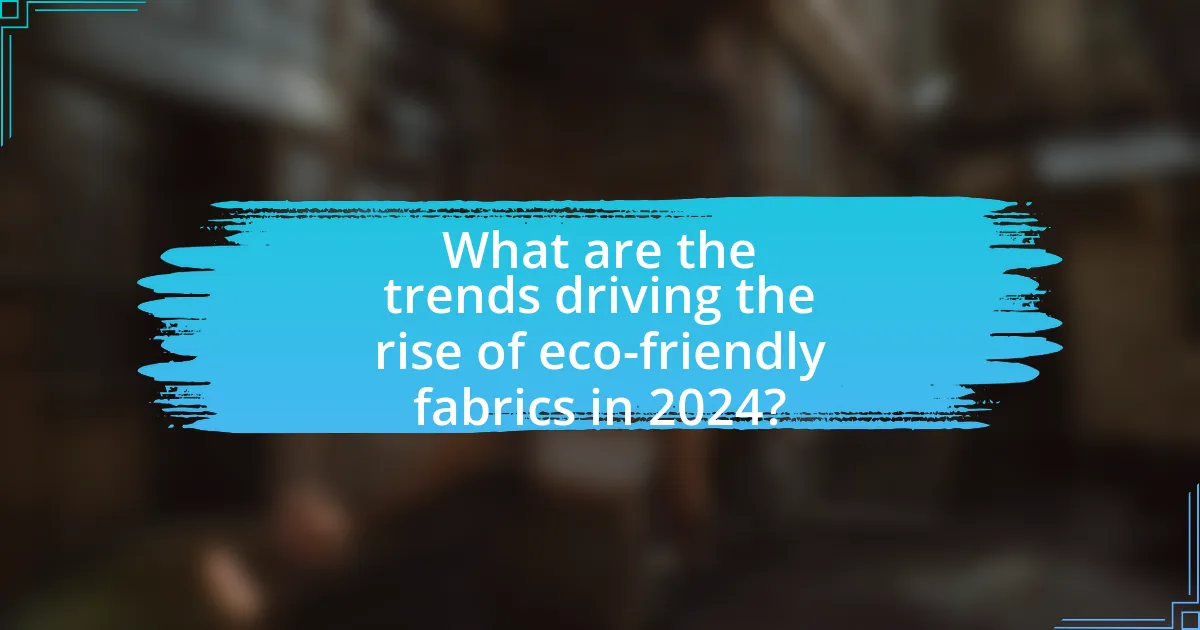
What are the trends driving the rise of eco-friendly fabrics in 2024?
The trends driving the rise of eco-friendly fabrics in 2024 include increased consumer demand for sustainability, advancements in textile technology, and regulatory pressures for environmental responsibility. Consumers are increasingly prioritizing sustainable products, with a 2023 survey indicating that 66% of global consumers are willing to pay more for eco-friendly clothing. Innovations in textile technology, such as the development of biodegradable materials and recycled fibers, are making eco-friendly options more accessible and affordable. Additionally, governments and organizations are implementing stricter regulations on textile waste and pollution, pushing brands to adopt sustainable practices. These factors collectively contribute to the growing prominence of eco-friendly fabrics in the fashion industry.
How are consumer preferences influencing fabric choices?
Consumer preferences are significantly influencing fabric choices by driving demand for sustainable and eco-friendly materials. As awareness of environmental issues grows, consumers increasingly favor fabrics made from organic, recycled, or biodegradable sources. For instance, a 2023 survey by McKinsey & Company found that 67% of consumers consider sustainability when making clothing purchases, leading brands to prioritize materials like Tencel, organic cotton, and recycled polyester. This shift not only reflects a change in consumer values but also compels manufacturers to innovate and adopt sustainable practices to meet market expectations.
What demographic factors are shaping the demand for eco-friendly fabrics?
The demand for eco-friendly fabrics is primarily shaped by the increasing awareness and preferences of younger consumers, particularly Millennials and Generation Z. These demographics prioritize sustainability and ethical production in their purchasing decisions, driving brands to adopt eco-friendly practices. According to a 2021 McKinsey report, 67% of consumers consider sustainability when making a purchase, with younger generations leading this trend. Additionally, urbanization and higher disposable incomes among these groups further contribute to the demand for sustainable fashion options, as they seek products that align with their values and lifestyle choices.
How does social media affect the popularity of Sustainable Fashion?
Social media significantly enhances the popularity of sustainable fashion by providing a platform for brands and consumers to share information and promote eco-friendly practices. The visual nature of platforms like Instagram and TikTok allows sustainable fashion brands to showcase their products, engage with audiences, and create viral trends around eco-conscious choices. According to a 2021 study by McKinsey & Company, 67% of consumers reported that social media influences their purchasing decisions, highlighting its role in shaping consumer behavior towards sustainable options. Additionally, influencers and activists use social media to raise awareness about the environmental impact of fast fashion, further driving interest in sustainable alternatives.
What innovations are emerging in eco-friendly fabric production?
Innovations in eco-friendly fabric production include the development of bio-based materials, such as fabrics made from agricultural waste, and the use of advanced recycling technologies that convert post-consumer textiles into new fibers. For instance, companies are now creating fabrics from pineapple leaves, orange peels, and other agricultural byproducts, significantly reducing reliance on petroleum-based fibers. Additionally, innovations like closed-loop recycling systems allow for the regeneration of fibers without degrading quality, as demonstrated by brands utilizing chemical recycling methods to produce new polyester from discarded plastic bottles. These advancements not only minimize environmental impact but also promote a circular economy in the textile industry.
What technologies are being developed to create sustainable textiles?
Technologies being developed to create sustainable textiles include bio-based materials, recycling processes, and innovative dyeing techniques. Bio-based materials, such as those derived from agricultural waste or algae, reduce reliance on petroleum-based fibers. Advanced recycling processes, like chemical recycling, allow for the breakdown of used textiles into their original fibers, enabling the creation of new fabrics without the need for virgin materials. Additionally, innovative dyeing techniques, such as waterless dyeing and natural dyes, minimize water usage and chemical pollution. These technologies collectively contribute to a more sustainable textile industry by reducing environmental impact and promoting circularity.
How are brands collaborating to enhance eco-friendly fabric options?
Brands are collaborating through partnerships and initiatives to enhance eco-friendly fabric options. For instance, major fashion companies are joining forces with textile innovators to develop sustainable materials, such as organic cotton and recycled polyester, which reduce environmental impact. A notable example is the collaboration between H&M and the Better Cotton Initiative, which aims to promote sustainable cotton farming practices. Additionally, brands like Stella McCartney are working with organizations such as the Ellen MacArthur Foundation to create circular fashion systems that prioritize the use of biodegradable and recyclable fabrics. These collaborations not only improve the availability of eco-friendly materials but also drive industry-wide standards for sustainability.
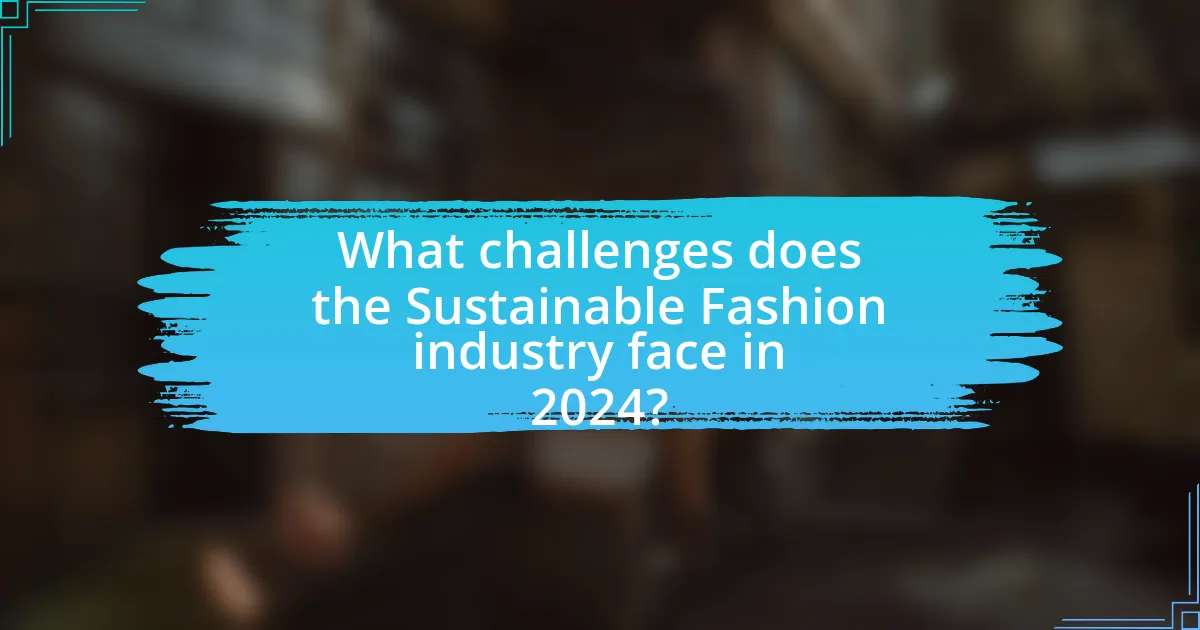
What challenges does the Sustainable Fashion industry face in 2024?
The Sustainable Fashion industry faces significant challenges in 2024, including high production costs, limited consumer awareness, and supply chain complexities. High production costs arise from the use of eco-friendly materials and ethical labor practices, which can lead to higher retail prices that deter price-sensitive consumers. Limited consumer awareness hampers the growth of sustainable fashion, as many shoppers remain uninformed about the environmental impact of their choices. Additionally, supply chain complexities, including sourcing sustainable materials and ensuring ethical practices throughout the production process, create logistical hurdles that can impede scalability. These challenges are compounded by the fast-paced nature of the fashion industry, which often prioritizes speed and cost over sustainability.
What are the barriers to widespread adoption of eco-friendly fabrics?
The barriers to widespread adoption of eco-friendly fabrics include higher production costs, limited availability, and consumer awareness. Higher production costs arise from the use of sustainable materials and processes, making eco-friendly fabrics more expensive than conventional options. Limited availability is due to a smaller number of manufacturers producing these fabrics, which restricts supply and variety. Additionally, consumer awareness is often low, as many shoppers are not informed about the benefits of eco-friendly fabrics or may prioritize price and convenience over sustainability. According to a 2021 report by McKinsey & Company, 66% of consumers expressed a willingness to pay more for sustainable products, yet only a fraction actively seek them out, highlighting the gap between interest and action.
How do cost and availability affect the use of eco-friendly fabrics?
Cost and availability significantly influence the adoption of eco-friendly fabrics in the fashion industry. Higher production costs associated with sustainable materials, such as organic cotton or recycled polyester, often lead to increased retail prices, making them less accessible to consumers compared to conventional fabrics. For instance, a report by the Textile Exchange indicates that organic cotton can cost up to 20% more than conventional cotton, which can deter budget-conscious consumers. Additionally, limited availability of eco-friendly fabrics can restrict designers and brands from incorporating them into their collections, as they may struggle to source sufficient quantities. This scarcity can result in longer lead times and higher procurement costs, further complicating the integration of sustainable options into mainstream fashion.
What role does legislation play in promoting Sustainable Fashion?
Legislation plays a crucial role in promoting Sustainable Fashion by establishing regulations that encourage environmentally friendly practices within the fashion industry. For instance, laws mandating transparency in supply chains compel brands to disclose their sourcing and production methods, thereby fostering accountability and sustainability. Additionally, legislation such as the European Union’s Green Deal aims to reduce textile waste and promote circular economy principles, which directly impacts how fashion companies design, produce, and dispose of their products. These regulatory frameworks not only incentivize sustainable practices but also create a competitive market for eco-friendly fabrics, driving innovation and consumer awareness in the industry.
How can consumers support the rise of eco-friendly fabrics?
Consumers can support the rise of eco-friendly fabrics by choosing to purchase clothing made from sustainable materials, such as organic cotton, hemp, or recycled fibers. By prioritizing these options, consumers drive demand for eco-friendly products, encouraging brands to invest in sustainable practices. According to a 2021 report by McKinsey & Company, 67% of consumers consider sustainability when making a purchase, indicating a significant market shift towards eco-conscious choices. This consumer behavior not only promotes the growth of eco-friendly fabric production but also influences the fashion industry to adopt more sustainable practices overall.
What are the best practices for choosing sustainable clothing?
The best practices for choosing sustainable clothing include selecting garments made from organic or recycled materials, prioritizing brands with transparent supply chains, and considering the longevity and versatility of the clothing. Organic materials, such as cotton grown without synthetic pesticides, reduce environmental impact, while recycled fabrics help minimize waste. Brands that disclose their sourcing and manufacturing processes demonstrate commitment to sustainability, as seen in companies like Patagonia, which emphasizes ethical production. Additionally, investing in high-quality, timeless pieces reduces the need for frequent replacements, aligning with sustainable consumption principles.
How can consumers advocate for more eco-friendly options in fashion?
Consumers can advocate for more eco-friendly options in fashion by actively supporting brands that prioritize sustainability and demanding transparency in production practices. By choosing to purchase from companies that use organic materials, recycled fabrics, and ethical labor practices, consumers can influence market trends. Research indicates that 66% of global consumers are willing to pay more for sustainable brands, demonstrating a clear demand for eco-friendly options. Additionally, consumers can engage in social media campaigns, sign petitions, and participate in community initiatives that promote sustainable fashion, thereby amplifying their voices and encouraging brands to adopt greener practices.
What are the future prospects for Sustainable Fashion and eco-friendly fabrics?
The future prospects for sustainable fashion and eco-friendly fabrics are highly promising, driven by increasing consumer demand for environmentally responsible products. The global sustainable fashion market is projected to grow from $6.35 billion in 2020 to $8.25 billion by 2023, reflecting a compound annual growth rate of 9.7%. This growth is fueled by heightened awareness of environmental issues, with 66% of consumers willing to pay more for sustainable brands, according to a 2021 survey by Nielsen. Additionally, advancements in technology are enabling the development of innovative eco-friendly materials, such as bio-based fabrics and recycled textiles, which further enhance the appeal of sustainable fashion.
How might consumer trends evolve in the coming years?
Consumer trends are likely to evolve towards increased demand for sustainable and eco-friendly products in the coming years. This shift is driven by growing awareness of environmental issues, with a 2021 survey indicating that 66% of global consumers are willing to pay more for sustainable brands. Additionally, the rise of social media influencers advocating for sustainable fashion is expected to further accelerate this trend, as consumers increasingly seek transparency and ethical practices from brands. As a result, companies that prioritize eco-friendly materials and sustainable practices are likely to gain a competitive advantage in the market.
What innovations could shape the future of eco-friendly fabrics?
Innovations such as bio-based materials, advanced recycling technologies, and smart textiles could significantly shape the future of eco-friendly fabrics. Bio-based materials, derived from renewable resources like algae and agricultural waste, reduce reliance on petroleum-based fibers and lower carbon footprints. Advanced recycling technologies, including chemical recycling, enable the transformation of post-consumer textiles back into high-quality fibers, minimizing waste and resource consumption. Smart textiles, which integrate sensors and responsive materials, can enhance functionality while promoting sustainability by reducing the need for multiple garments. These innovations collectively contribute to a more sustainable fashion industry by addressing environmental concerns and promoting circularity.







